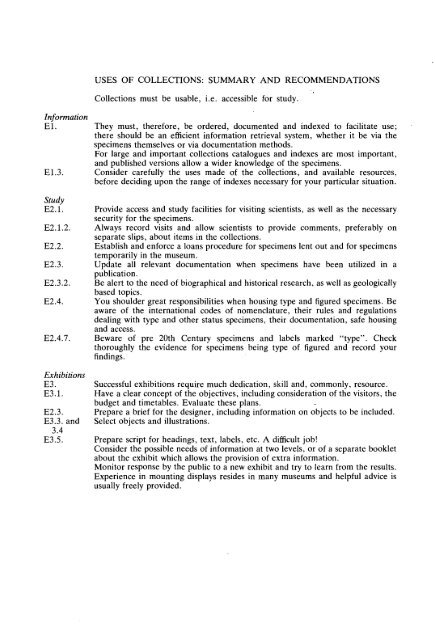GUIDELINES FOR THE CURATION OF GEOLOGICAL MATERIALS
GUIDELINES FOR THE CURATION OF GEOLOGICAL MATERIALS
GUIDELINES FOR THE CURATION OF GEOLOGICAL MATERIALS
Create successful ePaper yourself
Turn your PDF publications into a flip-book with our unique Google optimized e-Paper software.
Information<br />
El.<br />
E1.3.<br />
USES <strong>OF</strong> COLLECTIONS: SUMMARY AND RECOMMENDATIONS<br />
Collections must be usable, i.e. accessible for study.<br />
They must, therefore, be ordered, documented and indexed to facilitate use; <br />
there should be an efficient information retrieval system, whether it be via the <br />
specimens themselves or via documentation methods. <br />
For large and important collections catalogues and indexes are most important, <br />
and published versions allow a wider knowledge of the specimens. <br />
Consider carefully the uses made of the collections, and available resources, <br />
before deciding upon the range of indexes necessary for your particular situation. <br />
Study<br />
E2.1.<br />
E2.1.2.<br />
E2.2.<br />
E2.3.<br />
E2.3.2.<br />
E2.4.<br />
E2.4.7.<br />
Exhibitions<br />
E3.<br />
E3.1.<br />
E2.3.<br />
E3.3. and<br />
3.4<br />
E3.5.<br />
Provide access and study facilities for visiting scientists, as well as the necessary <br />
security for the specimens. <br />
Always record visits and allow scientists to provide comments, preferably on <br />
separate slips, about items in the collections. <br />
Establish and enforce a loans procedure for specimens lent out and for specimens <br />
temporarily in the museum. <br />
Update all relevant documentation when specimens have been utilized in a <br />
publication. <br />
Be alert to the need of biographical and historical research, as well as geologically <br />
based topics. <br />
You shoulder great responsibilities when housing type and figured specimens. Be <br />
aware of the international codes of nomenclature, their rules and regulations <br />
dealing with type and other status specimens, their documentation, safe housing <br />
and access. <br />
Beware of pre 20th Century specimens and labels marked "type". Check <br />
thoroughly the evidence for specimens being type of figured and record your <br />
findings. <br />
Successful exhibitions require much dedication, skill and, commonly, resource. <br />
Have a clear concept of the objectives, including consideration of the visitors, the <br />
budget and timetables. Evaluate these plans. <br />
Prepare a brief for the designer, including information on objects to be included. <br />
Select objects and illustrations. <br />
Prepare script for headings, text, labels, etc. A difficult job! <br />
Consider the possible needs of information at two levels, or of a separate booklet <br />
about the exhibit which allows the provision of extra information. <br />
Monitor response by the public to a new exhibit and try to learn from the results. <br />
Experience in mounting displays resides in many museums and helpful advice is <br />
usually freely provided.

















